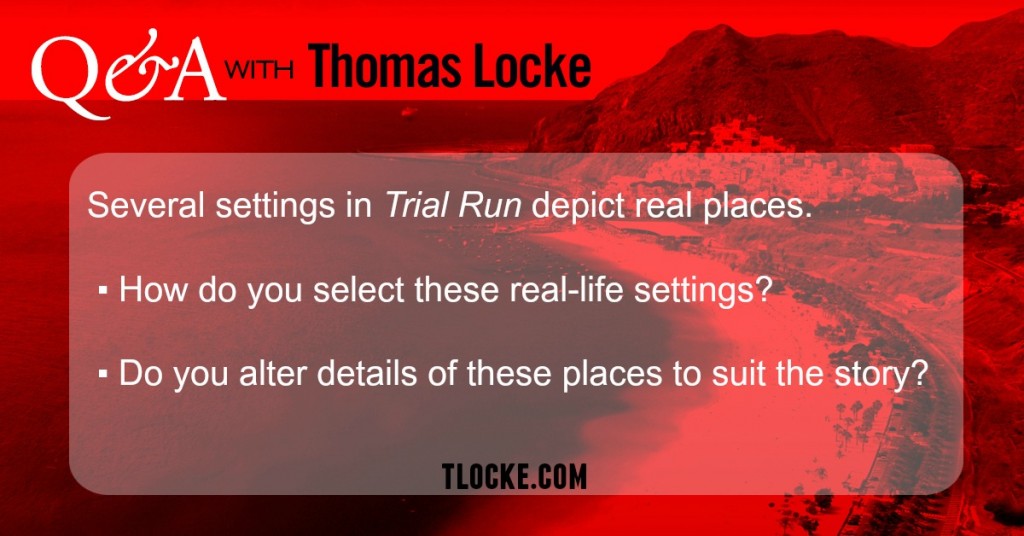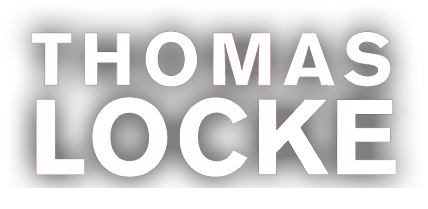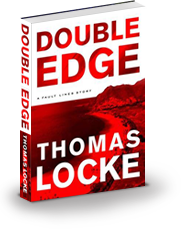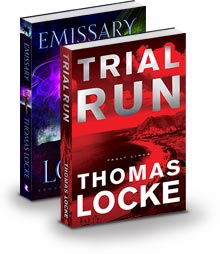 Q: Several settings in Trial Run (Santa Barbara, CA, the Italian/Swiss border site) depict real places. How do you select these real-life settings for your stories, and do you alter details of these places to suit your stories?
Q: Several settings in Trial Run (Santa Barbara, CA, the Italian/Swiss border site) depict real places. How do you select these real-life settings for your stories, and do you alter details of these places to suit your stories?
Thomas Locke: When John Grisham published The Client, a number of readers wrote in to say that he had shifted Washington DC’s geography in several crucial ways. John actually responded in the Afterword to his next novel, saying that it was his right as an author of fiction.
I won’t go that far, but I will say that I researched the area in California where much of the story is set.
The core element of my placing a story is research. And the core element in my research is emotion.
For many people, the ‘take’ that I finally use in the story does not jibe with what they like to see as valid for a particular setting, especially when that place is close to their heart and I have used a more negative perspective. But the facts have been carefully studied.
Santa Barbara, CA
An example from Trial Run is Santa Barbara. For a lot of people who know and love California, this is their absolute favorite place in the SoCal region. And for good reason. It is a lovely town, one my wife and I really enjoy visiting.
For this story, I was granted an insider’s view into the University of California at Santa Barbara, or UCSB. And from the perspective of many students enrolled there, UCSB is filled with hyper-inflated SoCal egos.
The contrast I found between the students with money (and in SoCal, when I say they had money, I really mean they had money) and those who don’t is as sharp as anywhere I have ever been. The student who formed my core source and guide was on a scholarship. He was there to study. He was, to say the least, in a minority.
Everything I described about the school, the bicycle traffic and the events on the beach and the housing, are based on observation. But the perspective was based upon the humorous bafflement with which this student viewed many of his fellow classmates.
 I personally love this aspect of building a story. The research at this emotional level grants me the opportunity to see the world through another person’s eyes and heart. Being trusted with this, time and again, is part of the miracle process that happens every time I start a new tale.
I personally love this aspect of building a story. The research at this emotional level grants me the opportunity to see the world through another person’s eyes and heart. Being trusted with this, time and again, is part of the miracle process that happens every time I start a new tale.
Trial Run releases August 4, 2015, from Revell.
Question for my readers:
Does it bother you when an author takes liberties with real-life settings?





In answer to your question regarding whether it bothers a reader when an author takes liberty with real-life settings, my answer is is both yes and no. I like to have things as real as possible in certain books, such as an historical fiction, but in a Techno-thriller like Trial Run, I’m not as picky. A work of fiction is just that – fiction. If an author picks a spot to wrap their novel around and decides to move a mounting or add a lake, well, it is fiction, so why not? But if a fiction author is writing a novel to be as close to reality as possible, using real places, then yes, if they move Starbucks across town, it bothers me. What this boils down to is this: an author using a real town/place needs to be as exact as possible, whereas an author choosing a place to model after but giving it a different name (etc), then they can change whatever they want because the place itself is fictional.